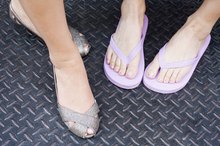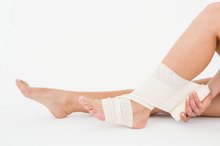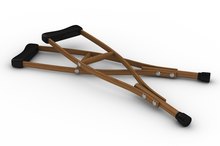5 Ways to Treat Haglund's Syndrome
Haglund's Syndrome vs. Haglund's Deformity
Haglund's syndrome is an inflammatory condition that could affect the area around your heel, where a small fluid-filled sac, called a bursa, allows the Achilles' tendon to slide smoothly over the bony ridge of your calcaneus (heel bone). When both the bursa and the tendon are inflamed, causing calcification to your heel bone, you could end up with a bony prominence called Haglund's deformity.
If you are experiencing serious medical symptoms, seek emergency treatment immediately.
Start the PRICE Plan
Haglund's syndrome starts with inflammation, so you'll feel stiffness or pain near the top of your heel bone in the back, especially in the mornings. As with most inflammatory processes of the soft tissues, if you treat it early, Haglund's syndrome can easily be managed. Start with the PRICE plan: Protection, Rest, Ice, Compression, Elevation. Stop the activity that's causing pain and swelling, prop the affected foot on pillows to give it a rest, put an ice pack on it for 15 to 20 minutes several times each day, and wrap the heel area with a compression bandage. Be sure not to wrap it so tightly that you feel a prickly sensation, as that means you've reduced the blood flow. You'll want to take an anti-inflammatory agent, such as ibuprofen or naproxen, too.
- Haglund's syndrome starts with inflammation, so you'll feel stiffness or pain near the top of your heel bone in the back, especially in the mornings.
- Stop the activity that's causing pain and swelling, prop the affected foot on pillows to give it a rest, put an ice pack on it for 15 to 20 minutes several times each day, and wrap the heel area with a compression bandage.
Try Different Shoes
The bursa on your heel can become irritated by constant rubbing or pressure of your shoe. It's a common complaint, especially for women who wear high heels frequently. Your Achilles' tendon may also be affected, either by the rubbing itself or through its functional position. Try different shoes that don't rub against the back of your heel.
- The bursa on your heel can become irritated by constant rubbing or pressure of your shoe.
- Try different shoes that don't rub against the back of your heel.
Get Moving Again
Runners are especially prone to Achilles' tendinitis through overuse or overstretching the tendon. Once you are out of an acute inflammatory phase for either bursitis or Achilles' tendinitis, try wearing a heel pad or other orthotic device in your running shoes for a while to reduce the strain on the Achilles' tendon, or try taping the area.
Surgery or Steroid Injections
If you already have Haglund's deformity, which is also known as the "pump bump," you may need surgery. If you do have surgery, your foot will be immobilized for a period of time afterward.
Cortisone injections to relieve the inflammation in the bursa or tendon are somewhat controversial, as they have been known to lead to rupture of the Achilles' tendon. However, a newer practice of using ultrasound to guide the injection may result in fewer drawbacks to this type of treatment. Early, aggressive treatment of inflammation around your heel bone may prevent Haglund's deformity and help keep you out of the surgical suite.
- If you already have Haglund's deformity, which is also known as the "pump bump," you may need surgery.
- Early, aggressive treatment of inflammation around your heel bone may prevent Haglund's deformity and help keep you out of the surgical suite.
Related Articles
References
- Vaishya R, Agarwal AK, Azizi AT, Vijay V. Haglund's Syndrome: A Commonly Seen Mysterious Condition. Cureus. 2016;8(10):e820. Published 2016 Oct 7. doi:10.7759/cureus.820
- Gupton M, Terreberry RR. Anatomy, Bony Pelvis and Lower Limb, Calcaneus. [Updated 2018 Dec 13]. In: StatPearls [Internet]. Treasure Island (FL): StatPearls Publishing; 2019 Jan-. Available from: https://www.ncbi.nlm.nih.gov/books/NBK519544/
- Vaishya R, Agarwal AK, Azizi AT, Vijay V. Haglund's Syndrome: A Commonly Seen Mysterious Condition. Cureus. 2016;8(10):e820. Published 2016 Oct 7. doi:10.7759/cureus.820
- Aronow MS. Posterior heel pain (retrocalcaneal bursitis, insertional and noninsertional Achilles tendinopathy). Clin Podiatr Med Surg. 2005;22(1):19-43.
- Pękala PA, Henry BM, Pękala JR, Piska K, Tomaszewski KA. The Achilles tendon and the retrocalcaneal bursa: An anatomical and radiological study [published correction appears in Bone Joint Res. 2019 Oct 3;8(9):437]. Bone Joint Res. 2017;6(7):446–451. doi:10.1302/2046-3758.67.BJR-2016-0340.R1
- Sofka CM, Adler RS, Positano R, Pavlov H, Luchs JS. Haglund's syndrome: diagnosis and treatment using sonography. HSS J. 2006;2(1):27–29. doi:10.1007/s11420-005-0129-8
- Vonhof J. Fixing Your Feet. Pthomegroup. Injury Prevention and Treatments for Athletes. 2016.
- Jiang Y, Li Y, Tao T, et al. The Double-Row Suture Technique: A Better Option for the Treatment of Haglund Syndrome. Biomed Res Int. 2016;2016:1895948. doi:10.1155/2016/1895948
- Chimenti RL, Cychosz CC, Hall MM, Phisitkul P. Current Concepts Review Update: Insertional Achilles Tendinopathy. Foot Ankle Int. 2017;38(10):1160–1169. doi:10.1177/1071100717723127
Writer Bio
This article was written by the CareerTrend team, copy edited and fact checked through a multi-point auditing system, in efforts to ensure our readers only receive the best information. To submit your questions or ideas, or to simply learn more about CareerTrend, contact us [here](http://careertrend.com/about-us).








